Periyar’s maintenance engineers
After walking the length and breadth of Periyar, Dr. Anish Andheria writes with both knowledge and passion about the array of wildlife that has made this tropical forest a home. From termites and dracos, to tigers and martens, he covers the gamut of life that keeps this paradise functional.
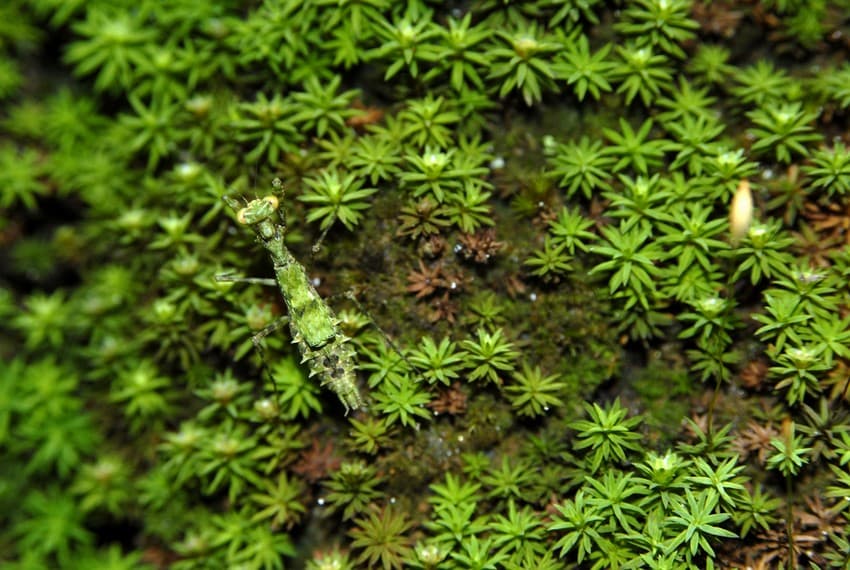
Camouflaged to perfection against a backdrop of moss (Pogonatum sp.), a praying mantis nymph awaits a prospective meal. Photo: Dr. Anish Andheria
The sun had vanished behind the mountains and the sky had turned from ochre to deep grey. Visibility was down to a few feet. Suddenly, a loud buzzing sound resembling distant traffic on an eight-lane highway caught my attention. Within seconds, they started flying into my face. Hundreds upon hundreds of insects, some in my ear, others down my shirt and still more trying to crawl into my nose and mouth.
I was engulfed by a veritable cloud of termites all eager to find a mate, shed their wings and commence their own respective colonies. It was an ancient ritual that had taken place on Earth for millions of years before Homo sapiens was even a glint on the evolutionary horizon. I lunged for my headlamp and made my way purposefully towards the densest portion of the swarm, the buzz of wings getting ever louder as I neared the epicentre. I had no idea how many insects there were around me but guessed there would be several thousand. The true dimension of the phenomenon I was witnessing only came alive in the beam of my headlamp. I saw a stream of termites burst forth from a tiny five-centimetre opening in the forest floor, the endless stream adding to the already dense cloud above me.
Astonished by this huge nuptial exodus, I sat down beside the mound and contemplated the survival strategy that nature had provided such defenceless creatures, whose sheer numbers helped them easily achieve the objective of finding mates, while surviving predators outside their secure nest. This is how their genetic chain was successfully passed down, secure, over the ages.
Every creature alive on Earth today is the product of equally effective and unique survival strategies gifted by evolution through natural selection.
Covered by a thick sheet of hyperactive termites, I lay motionless for another 15 minutes, marvelling at the productivity of Periyar’s tropical ecosystem that was able to support such insect invasions and more. The weight of the termites would easily outweigh Periyar’s large mammal population, indicating just how vital they are to the health of the ecosystem.
Soon, the insects were all but gone, leaving behind a signature carpet of discarded wings. I too got up, dusted off wings and mud, and completed the last lap of my day-long trek in the Kurisumala mountain (Mountain of the Cross) in the company of my guide, Rajan. I was on Periyar’s famous Cloud Walk trail, and had walked through some of the most picturesque valleys towards the north-western edge of the tiger reserve.
My love affair with Periyar and its larger-than-life emerald jungles dates back to 1988 when I first visited the park as part of a nature club excursion. I still vividly recollect the first two-kilometre walk from the park entrance to the famous jetty, in the course of which I saw 84 species of birds on a pleasant winter morning.
The image of White-bellied Treepies, flocks of Malabar Parakeets, Vernal Hanging Parrots, Hill Mynas, Tawnybellied Babblers and a pair of Great Hornbills elegantly gliding over a 100-metre stretch of the backwaters, will remain etched in my mind forever.
Spirited sorties of the omnipresent Indian giant squirrel Ratufa indica to the very tip of a silk cotton Bombax ceiba branch still have me wondering how a large-sized squirrel could be supported by those slender extremities.
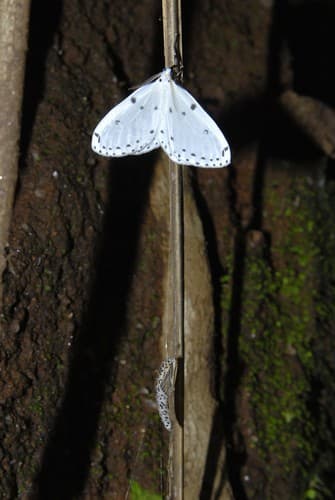
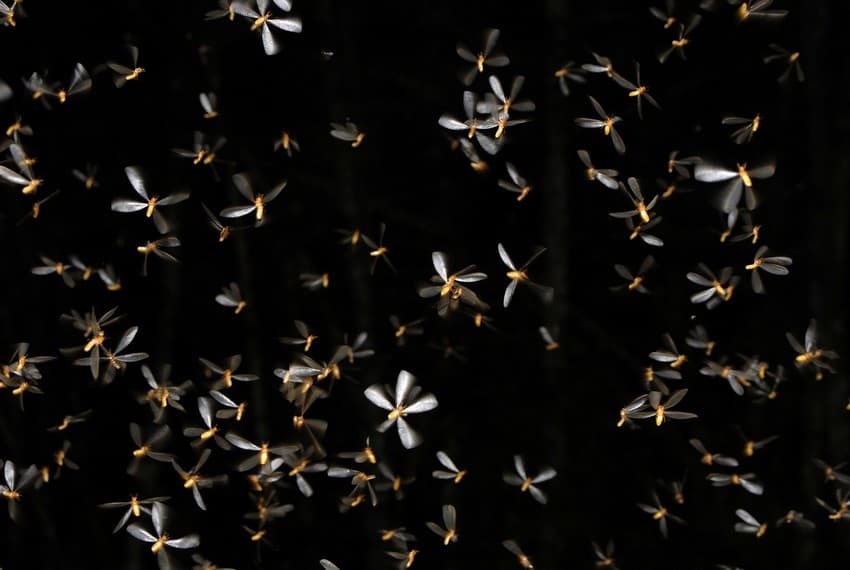
This drama between predator and prey unfolds continuously across every inch of Periyar’s evergreen forest, whose most charismatic animals are elephants, tigers and gaur, but whose maintenance engineers include a vast army of winged termites (Order Isoptera), photographed here (bottom) against the dark jungle gloom. Unlike most moth species, this one (top) is active during the day and even emerges from its pupa in broad daylight. Moths have a finely-honed sense of smell that helps them locate blooms even in pitch darkness. Photos: Dr. Anish Andheria
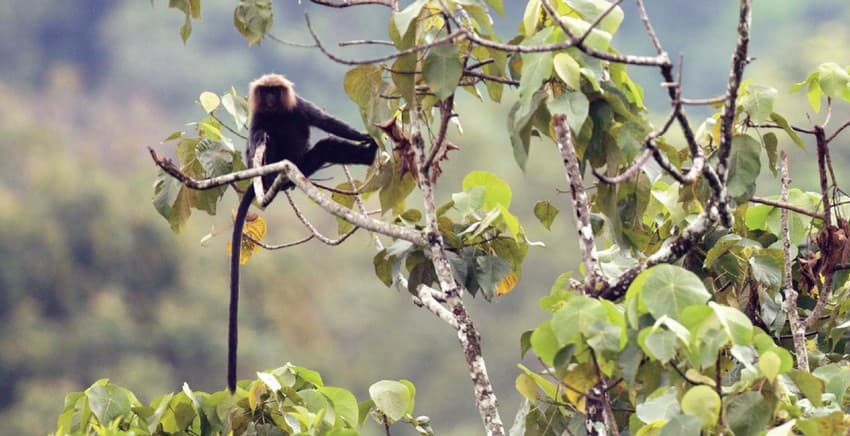
Photo: Sandesh Kadur
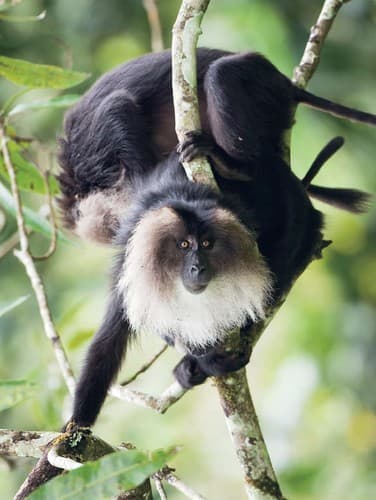
The Nilgiri langur Trachypithecus johnii (top) is endemic to the southern Western Ghats and its “hookoo-hookoo” calls reverberate across the evergreen, semi-evergreen and deciduous forests of the Periyar Tiger Reserve. Ganja (marijuana) cultivators take a heavy toll on these handsome animals and many die of electrocution in and around Thekkady. Lion-tailed macaques Macaca silenus (bottom), however, are confined to the evergreen stretches of the tiger reserve and in cardamom estates in the Theni, Ranni and Kottayam Divisions. Frequently sighted in the forests of the Koruthodu- Sabarimala area, they move up montane tracts along the interstate border in Upper Manalar and Vellimala in search of plant foods.
Almost two decades and many visits later, not a lot has changed in Periyar, and what has, is mostly for the better. The walk from the gate to the boat landing still yields great birding experiences, with an occasional night-time sighting of the elusive mouse deer Moschiola meminna and Indian porcupine Hystrix indica thrown in.
Periyar House and Aranya Nivas remain my favourite places to stay, largely because they are in the heart of the forest and all I need to do is step out into the compound to experience the nocturnal life of the park. However, one thing that has changed, is the number of visitors. The park was always popular, but in the past six or seven years, an explosion of tourists has taken place and while this is welcome because it gives us a chance to orient more people, it also poses its own set of problems, principally more noise, more litter and more stress on the protection staff.
A sensitive park management has, nevertheless, successfully handled the situation so far. A vast improvement has been seen in the new trekking, hiking and camping regime organised by the authorities, with help from locals who know the forest extremely well. These programmes offer a first-hand forest experience to curious visitors, even as they educate people and help interpret park objectives by way of one-on-one interaction during long walks. I am positive that many casual visitors will return as supporters, possibly as future naturalists.
Walking in the forest, in my view, is the finest way to unravel nature’s tightly-kept secrets. The Cloud Walk I took earlier, for instance, yielded a vast assortment of life forms, including largely nocturnal frogs, which in the gloom of the jungle, seem to extend their activities in suitable, cool, damp patches. This is where I stumbled upon three of Periyar’s most common frogs – the bi-coloured frog Clinotarsus curtipes (earlier called Rana curtipes) in its golden-yellow breeding attire, Beddome’s leaping frog Indirana beddomii jumping about at the slightest hint of disturbance and the young ones of the ubiquitous cricket frog Fejervarya limnocharis that I saw scampering over near vertical, moss-laden rocks.
Trained down the years to look for things that want to stay hidden, I was even able to spot a praying mantis nymph, that was so well camouflaged that I was only able to spot it when it moved, which is also how they get picked up by predators such as birds and lizards.
A very significant percentage of Periyar’s wild niches are located out of direct sight, high on great wooden pillars – towering tropical trees. To an untrained eye, the forest floor too appears relatively listless. Of course, it is far from that. The forest floor is not merely crowded with a profusion of saplings and shade-loving bushes, but also by more ‘lowly’ plants such as Zingiber, Aeginetia and Pogonatum that cling to the floor and are often themselves ‘camouflaged’ by the leaf litter that falls to the ground.
These varied strata – upper canopy, middle canopy, lower canopy, shrubbery and forest floor – share a complex association of emergent and secondary vegetation that is the foundation of Periyar’s opulent biodiversity.
Covered by a thick sheet of hyperactive termites, I lay motionless for another 15 minutes, marvelling at the productivity of Periyar’s tropical ecosystem that was able to support such insect invasions and more.
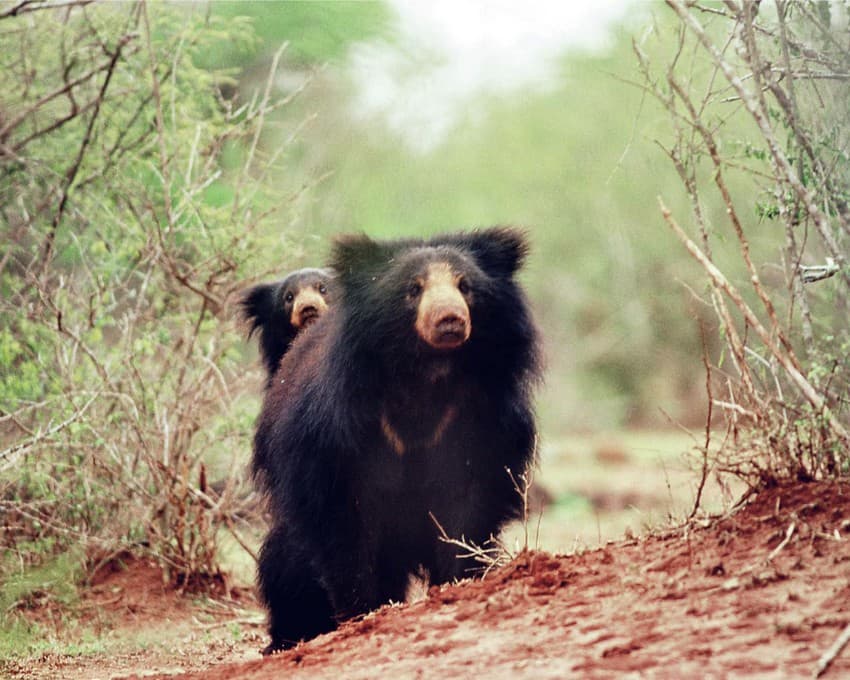
The care of the young is left wholly to the mother sloth bear Melursus ursinus, who carries her cubs on her back in the manner of ant eaters. She will defend her young ones fiercely against all perceived threats until they are two or three years old. Photo: N.A. Naseer

Photo: Sali Palode
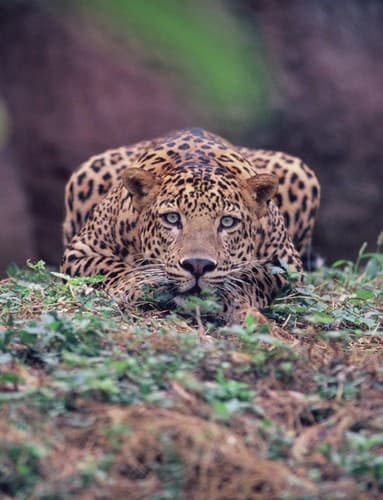
Chital Axis axis are not found in Periyar. Sambar Cervus unicolor (top) are the dominant deer species and an important food source for the three sympatric large carnivores – tiger Panthera tigris, leopard Panthera pardus (bottom) and dhole Cuon alpinus. Tigers, on account of their large body size and power, and dholes, their pack hunting strategies, are able to being down animals larger than themselves. However, the solitary leopard is unlikely to take on a large sambar stag, and must be content to prey on fawns and other juveniles. Photo: Baiju Patil
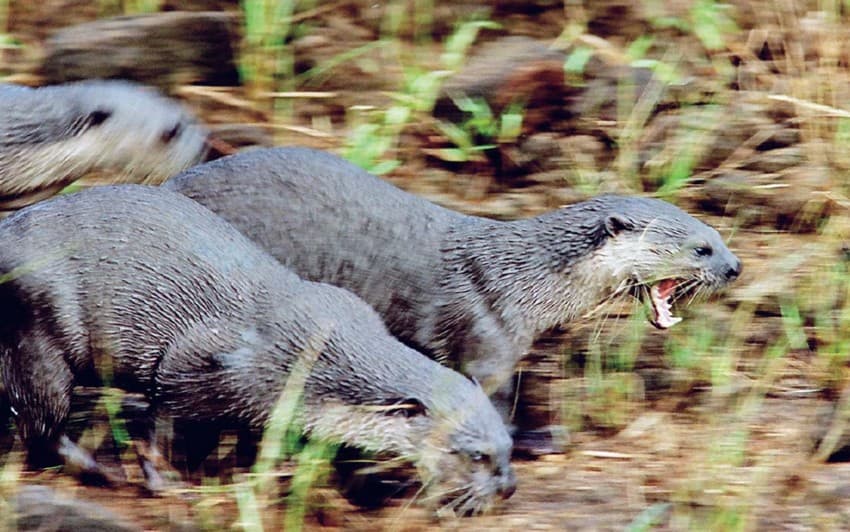
Smooth-coated otters Lutrogale perspicillata (top) are charismatic, aquatic mammals found along river courses, vayals and the Periyar lake shore. They are vulnerable to dramatic rises in water levels as this could submerge their dens. Fish nets and toxins brought in during the monsoon, when sewage and effluents from Kumily overflow into the lake, also take a toll on otters. Photo: N.A. Naseer
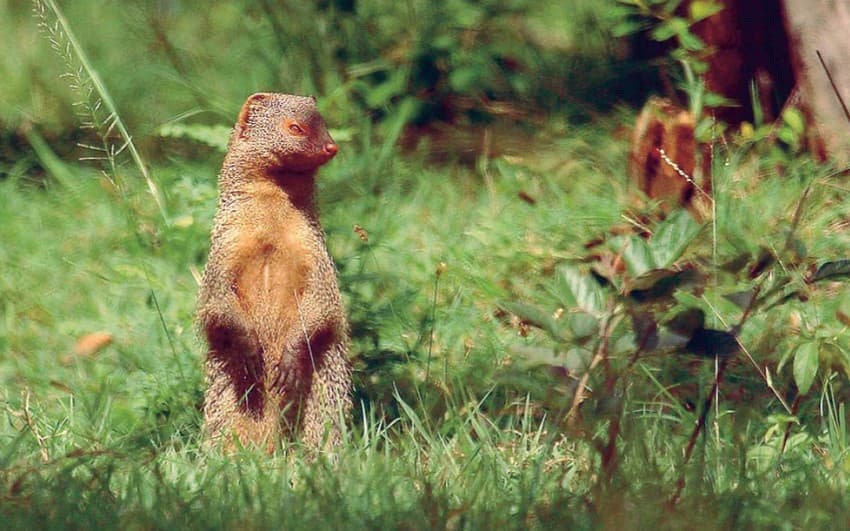
The common grey mongoose Herpestes edwardsii (bottom) lives in burrows, tree hollows and rocky crevices. A master predator, it will take rodents, birds and their nestlings, or even a snake if it gets the chance. Photo: Jayanth Sharma
In popular literature, when the word ‘jungle’ is mentioned, more often than not what comes to mind are the larger animals – elephants, tigers, leopards, monkeys and the like. If this is all you search for in such ‘jungles’, you will be disappointed, for the thick vegetation coupled with the relatively low density of mega fauna means you will see little or nothing on nine out of 10 trips, apart from a surprised sambar or a jittery barking deer or fleeting glimpses of some black shadow in the canopy.
In truth, I too was brought up with the notion that Indian jungles sported concentrated wildlife conglomerations, like some kind of glorified zoological garden. My first few walks as a 20-year-old through Karnataka’s Dandeli Wildlife Sanctuary left me predictably dejected because tigers, elephants and sloth bears did not instantly reveal themselves to me, and drama never burst out from behind every thicket!
Of course, it did not help that I had so far been reared on a diet of Ranthambhore and Kanha, where good year-round visibility made sightings commonplace. Since then, repeated study trips to the Western Ghats taught me where life hides safe from harm in rainforests. And, to my utter delight, where forests once seemed empty, today I find them so stocked with life that I must tear myself away every 100 m. or so from theatre after living theatre, as I delve into the world of ants, spiders, beetles, mantises, frogs, lizards and snakes. If anything, I discovered in the nicest possible way, these multi-tier evergreen forests are busier than virtually any other ecosystem on Earth, with the possible exception of bustling coral reefs in tropical seas.
If you care to walk in Periyar, with no specific agenda in mind other than to experience and observe, within four hours you could cut through habitats ranging from tropical evergreen and semi-evergreen to moist deciduous, to southern montane wet temperate, (the sholas) and, of course, those crucial fodder-factories where countless herbivores seek sustenance – the grasslands.
The rule of thumb, in forests that enjoy a year-round water supply is that the diversity of animals is directly linked to the number of strata (layers). The more the strata, the higher the diversity. That is why we find greater plant and animal diversity in Periyar’s multi-layered evergreen stretches than its deciduous belts, and more in its deciduous belts than we do in high altitude grasslands studded with relatively small outcrops of shola forest.
Something that I understood along the way, by walking in Indian wildernesses, was that large mammals and birds, though they automatically drew more attention to themselves, contributed much less to the overall biodiversity of a habitat than the microscopic decomposers, insects, other invertebrates, fungi and mosses that most people gloss over.
This takes nothing away from the joy and the ecological importance of Periyar’s elephants Elephas maximus, gaur Bos gaurus, sambar Cervus unicolor, Nilgiri langurs Trachypithecus johnii, Indian giant squirrels Ratufa indica, tigers Panthera tigris, leopards Panthera pardus or dholes Cuon alpinus. In a sense, these are our most visible indicators of the vibrancy and health of ecosystems. But in real terms, they contribute to only a small percentage of the biomass (total weight of all living organisms) of Periyar.
The image of White-bellied Treepies, flocks of Malabar Parakeets, Vernal Hanging Parrots, Hill Mynas, Tawny-bellied Babblers and a pair of Great Hornbills elegantly gliding over a 100-metre stretch of the backwaters, will remain etched in my mind forever.
Sightings of tigers, leopards, elephants and gaur dominate the vistas we visit, but they are not found in extraordinary densities, unlike the termites I described above. Interestingly, Indian giant squirrels, Nilgiri langurs and sambar, though they are small or medium-sized, can be found in comparatively higher densities and are, therefore, more frequently seen by us.
Food determines animal behaviour. This is why elephants and gaur congregate along the banks of the Periyar reservoir, especially during the dry months, where visitors can see them easily. But people who opt for the fascinating one-day or twoday treks organised in Periyar are just as likely to see these magnificent herbivores on grassy upper slopes.
One way or the other, the reservoir is nevertheless, the heart of the reserve now. It is also where I almost witnessed what might well have been my most exciting wildlife episode. I was returning to the jetty after a long boat ride to Mullakkudi on a winter evening in 1998. Two tourist boats, relatively close to the bank, suggested that some jungle drama or other was at play. We moved closer and saw a pack of 12 dholes devouring a freshly-killed sambar doe (the intelligent canids seem to know the sambar’s inherent fear of deep water and drive their quarry to it). Once the escape route is sealed, the pack closes in and a 90-100 kg. animal can be reduced to bare bones within minutes by a sufficiently large pack.
I left the dholes at their kill after five minutes or so and returned to shore. Later that evening, two foreign tourists showed me what had transpired after I had (foolishly) departed. Virtually seconds after we were gone, a tiger emerged from behind cover to kill a dhole on the edge of the pack. The victim was obviously absorbed in the pack hunt and it, therefore, became the tiger’s next meal even as the rest of the 11-strong pack, unaware that one of theirs had been killed, continued to feed. I played the footage back over and over again to understand what exactly happened and found myself even more in awe of raw nature where the hunter could become the hunted within one careless moment.
How little we really know about the world of the wild! Conventional wisdom always suggested that tigers avoid dhole packs and jungle tales are filled with stories of large packs driving tigers away from their own hard-earned kills, but here was another side of the picture, one I might have disbelieved had I not seen it on the amateur video.
The only fixed rule in the jungle is that there are no fixed rules. Kill or be killed. Eat or be eaten, is what determines the pulse of life. That night as I sat out on the jetty rewinding my memories of the day, I imagined the tiger watching the dhole-hunt from hiding. The large pack-size would have deterred it from contemplating a raid on their kill, but the feeding frenzy provided the striped predator an unusual opportunity and it took advantage in an instant of pure genius. As I sit to write of that memory, a decade later, my heart still beats faster.
A very significant percentage of Periyar’s wild niches are located out of direct sight, high on great wooden pillars – towering tropical trees. To an untrained eye, the forest floor too appears relatively listless. Of course, it is far from that.
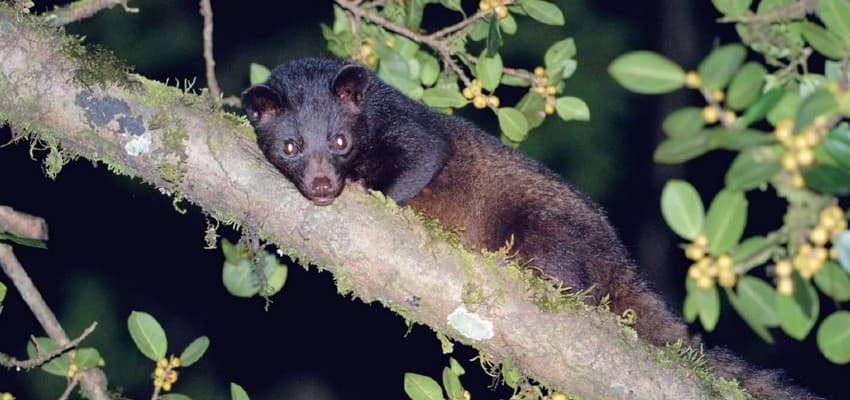
Habitat fragmentation and poaching are the principal threats to the Jerdon’s palm civet or brown palm civet Paradoxurus jerdoni. Classified as threatened by IUCN’s Red Data List, this fruit eater will also gladly take insects, rodents and birds. Photo: Kalyan Varma
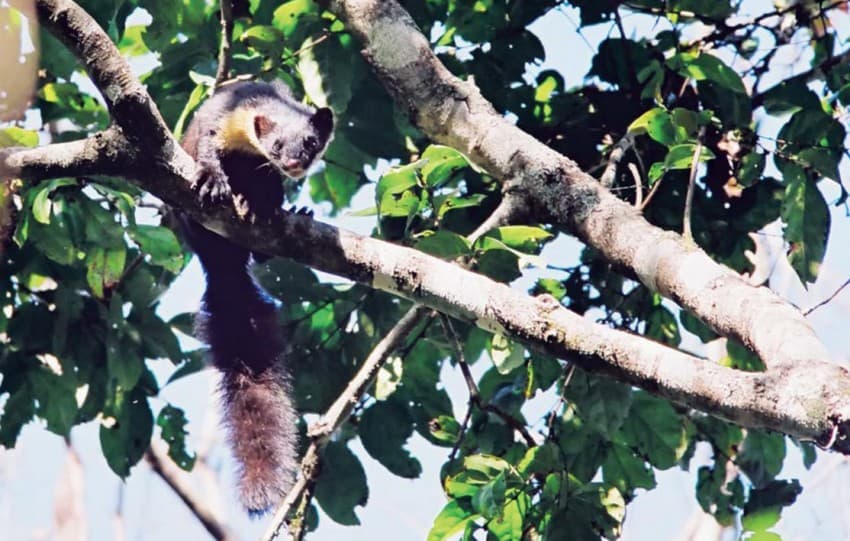
The rarely seen Nilgiri marten Martes gwatkinsii is larger than its yellow-throated Himalayan cousin and prefers to hunt in trees, though it is not averse to preying on rodents, insects and other small animals, including mouse deer on the forest floor. Photo: N.A. Naseer
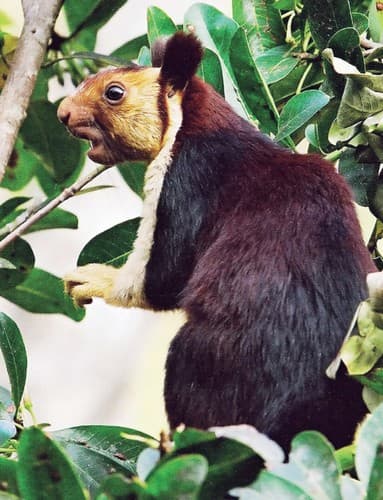
The Indian giant squirrel Ratufa indica, on the other hand, rarely comes down to the ground and is capable of making great leaps from tree to tree. Found across peninsular India, this rodent is secure in Periyar, but is also one of the first victims of forest degradation outside, as its survival is directly linked to the density and health of forest canopies to which it is perfectly adapted. Photo: N.A. Naseer
It is normal for big charismatic mammals to command feelings of awe in us. But give yourself half a chance to enter other domains and you could be just as hooked to diversity as I am today. I recall a walk through the Cullenia-dominated evergreen forest between Uppupara and Sabarimala in early 1990s, when I saw my first lion-tailed macaque Macaca silenus. It was just a 20-second sighting, but I had followed the sounds and shadows of the endangered primate for over an hour before I got that fleeting glimpse and the experience left me replete with joy. It was a male in all its glory, ivory back-lit mane, black body, piercing eyes and prominent tail tuft; it is a moment I still cherish dearly, one that more than made up for the tough walk through the slush, the drenching by an unseasonal shower and the many leeches I had to carefully remove from my person.
On another trek from the Kokkara camp to Mangaladevi through spectacular moist semi-evergreen forests I saw those other rarities of Periyar – Nilgiri tahr. They belong to both Tamil Nadu and Kerala, and it worries me today that their numbers have come down from 35 or so animals in 1997 to just 20 today. They are restricted to the habitat around the interstate boundary that forms the northern limit of Periyar, just a few hundred metres from the Mangaladevi watchtower. An hour spent watching them seemed to flash by in a minute, as they negotiated near vertical, grassy slopes. But the icing on my cake had been stolen by an earlier sighting I was lucky enough to witness in the semi-evergreen forests below.
Periyar’s management has been able to cope with the increased number of visitors by diverting them from boating to trekking, hiking and camping with help from locals who know the forest inside out. These programmes help interpret park objectives through one-on-one interaction during long walks.
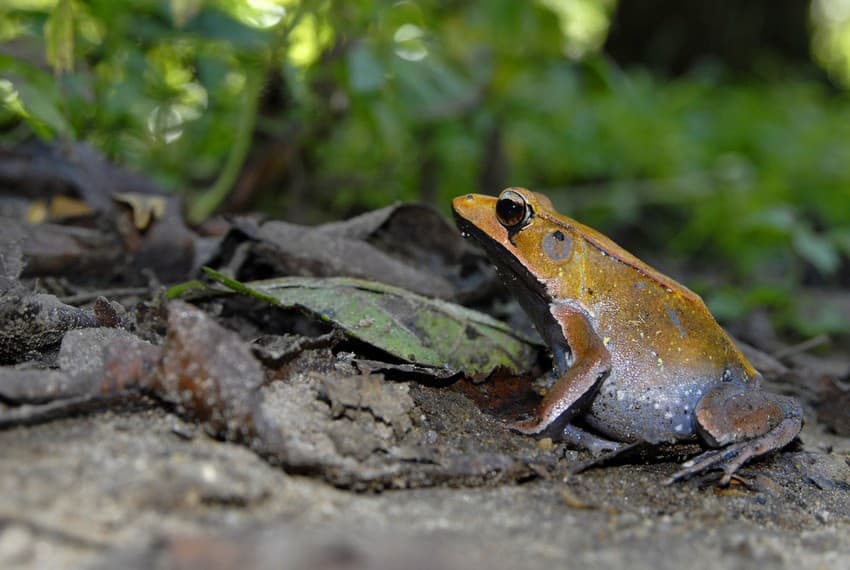
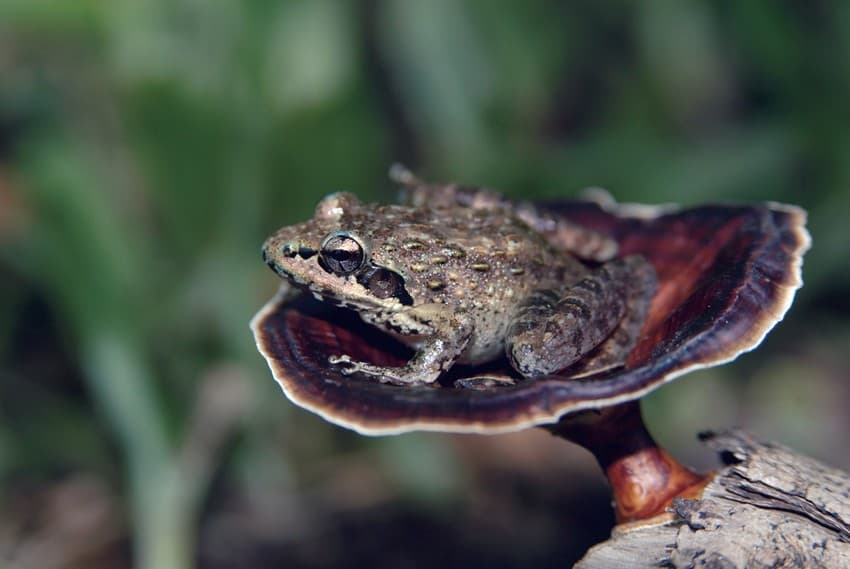
A tropical climate and abundant rain combine to create rich and varied niches that offer safe haven to a myriad amphibians, of which some, including the bi-coloured frog Clinotarsus curtipes (top) and the Beddome’s leaping frog Indirana beddomii (bottom) are endemic to the Western Ghats. The leaf litter, the most nutrient-and species-rich strata, is a favourite hunting ground for both these frogs. Photos: Dr. Anish Andheria
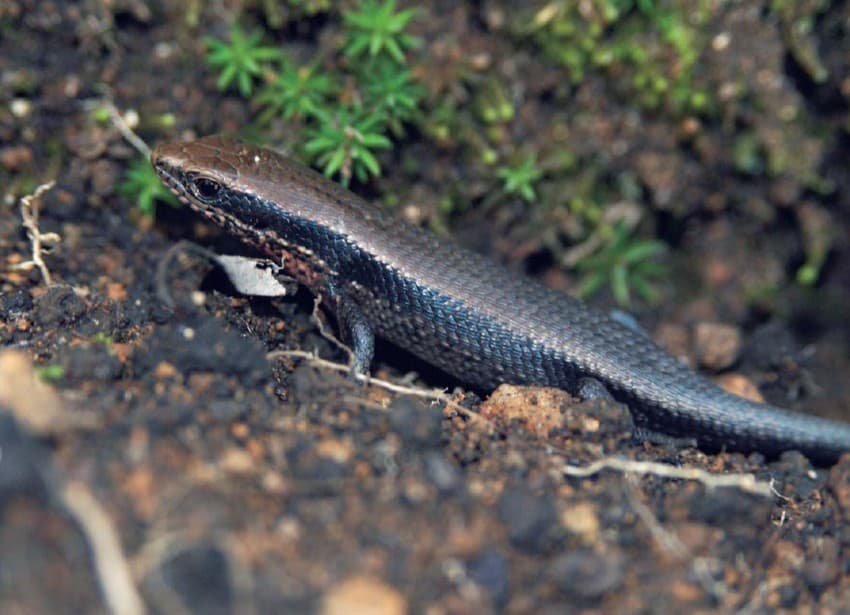
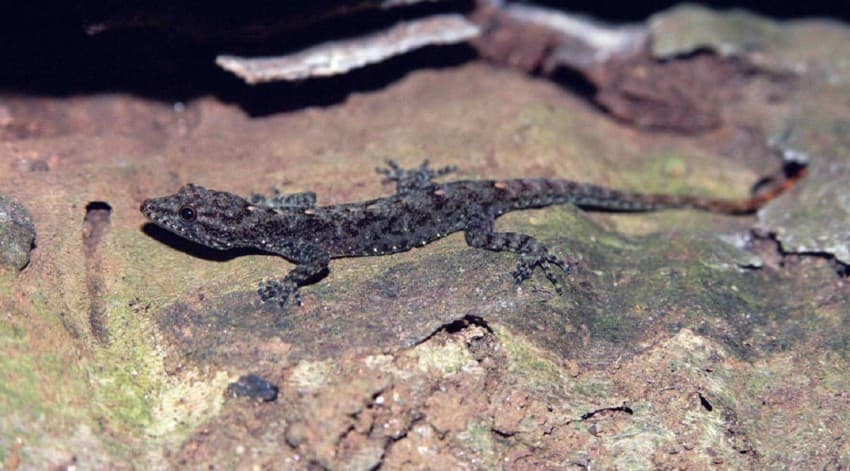
Also found here is another specialised insect-hunter, the bronze grass skink Mabuya macularius (top) that seldom grows beyond 100 mm. The Indian day gecko Cnemaspis indica (bottom), however, is found on trees and on rocks. Geckos belonging to the genus Cnemaspis have circular pupils, unlike other geckos that possess vertical slit-like pupils. Photos: Dr. Anish Andheria
En route to the Mangaladevi watchtower, I had stopped at a strong, flowing stream to photograph the black-tipped forest glory Vestalis apicalis, a large iridescent damselfly. Suddenly, a movement on the far bank caught my eye. Two dark palm civet-sized animals appeared periodically through the gaps in the shrubbery, moving in a zigzag pattern towards the stream. They seemed unaware of, or unconcerned by, my presence and I imagine the gurgling sound of the stream might have obliterated the noise I had made while approaching the stream. The light was poor and the undergrowth too dense to allow a clear view and I sat quietly, binoculars glued to my eyes, to try and identify the animals. They were certainly not common palm civets Paradoxurus hermaphroditus, or brown palm civets Paradoxurus jerdoni. Both of those would not be out in daylight as they are strictly nocturnal. The forms I saw were too dark to be striped-necked Herpestes vitticollis, or ruddy Herpestes smithii, or grey mongooses Herpestes edwardsii. As one of the creatures came momentarily into a clear patch, I saw a distinctly pale underbelly that had ruled out the brown mongoose Herpestes brachyurus, which is largely uniform in colour. I knew Periyar harboured all the above creatures, but these resembled none of them.
As I resigned myself to yet another tantalising, unidentified sighting, one of them entered the stream and then the second. They were now in full view and my day, no, my entire life had been made – I had seen the largest, most endangered marten in India – the Nilgiri marten Martes gwatkinsii. I could hardly believe my luck for this was one of the rarest and the most enigmatic mammals of the Indian subcontinent. Even as I sat contemplating my good fortune, the two walked gingerly across the shallow stream until the dark shadows of the towering forest engulfed them forever. I was now a part of the miniscule elite that had seen a Nilgiri marten.
Life was good.
If you walk in Periyar, with no specific agenda in mind other than to experience and observe, within four hours you could cut through habitats ranging from tropical evergreen and semi-evergreen to moist deciduous, to southern montane wet temperate (the sholas) and its fodder factories – the grasslands.
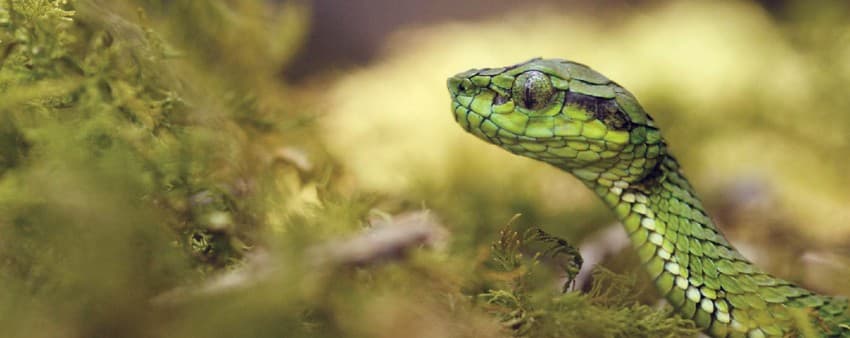
Photo: Kalyan Varma
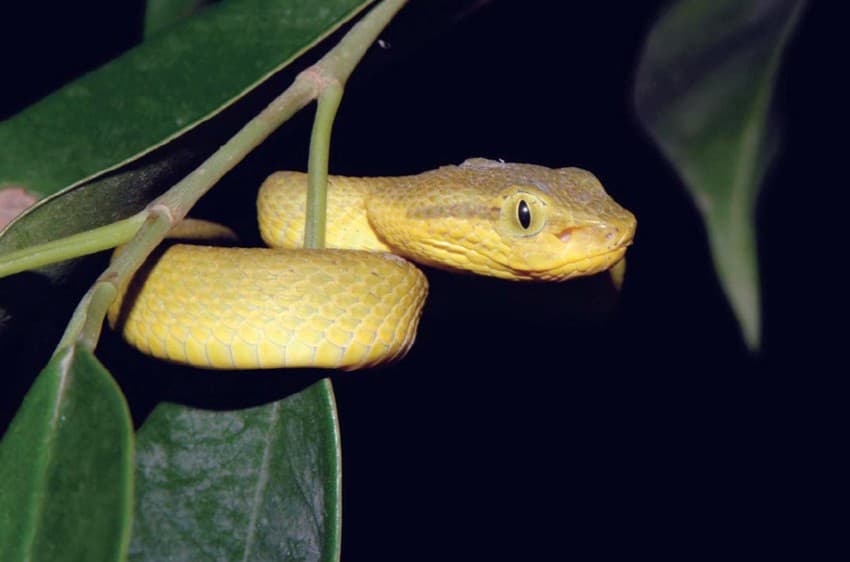
Photo: Dr. Anish Andheria
Periyar is a reptile haven and creatures such as the large-scaled pit viper Trimeresurus macrolepis (top) and the bamboo pit viper Trimeresurus gramineus (bottom) are superbly adapted to the rainforest ecosystem. While it is a well-known fact that snakes are equipped with infrared imaging capabilities to hunt down warm-blooded prey, recent reports also suggest that they may also help them evaluate whether it is more advisable to warn off potential enemies with mock strikes, or to slink away to safety.
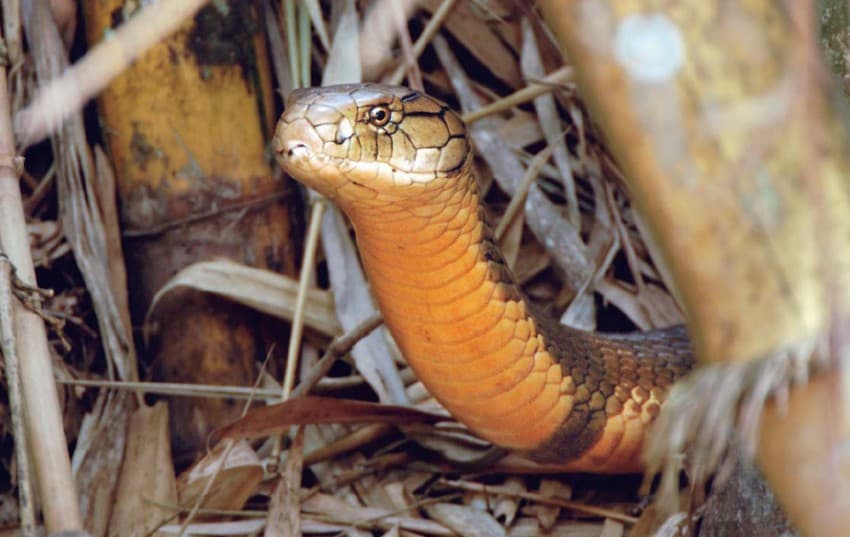
The king cobra Ophiophagus hannah is one of the largest venomous snakes in the world, and feeds exclusively on other snakes. Photo: Kalyan Varma
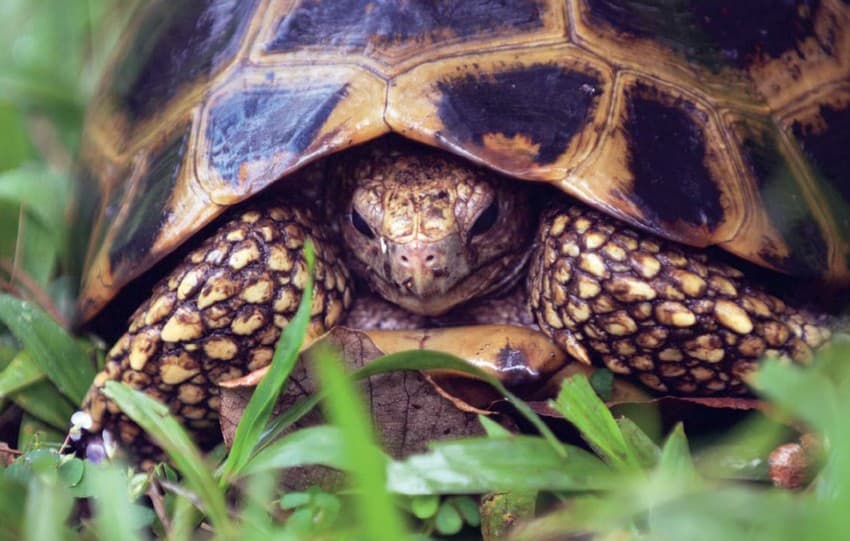
The Travancore tortoise Indotestudo travancorica is endemic to the Western Ghats in southwestern India. Photo: Ramnath Chandrasekhar
You cannot claim to have done justice to the great and small creatures of Periyar unless you have spent time with its reptiles. I had the checklist with me as I poked around the underbrush, behind and under rocks to search for any of Periyar’s 45 reptiles. A reptile-friendly habitat if ever I saw one, Periyar and similar wildernesses in South India compare well in terms of reptile diversity with the evergreen and semi-evergreen forests of Northeast India. Light has much to do with this as it does determine reptile behaviour to an extent, because the perpetual dimness and often the total absence of direct sunshine make it easier for these hideand- hunt predators to launch successful strikes against their prey. Of course, in Periyar’s dark forests, it also makes reptiles next to impossible to see. But, if you know the kind of places they rest and you understand the metabolism of the cold-blooded creatures, their veiled world does reveal itself.
Species such as the keeled grass skink Mabuya carinata, the garden lizard Calotes versicolor, the Bengal monitor Varanus bengalensis and geckos, including the Indian day Cnemaspis indica, Brook’s house Hemidactylus brookii and Asian house geckos H. frenatus, are relatively easy to see, but you need to have a ‘search image’ etched in your mind for them and that comes from experience (if you lack the experience go with someone who has it, and soon the ‘search image’ will be yours too).
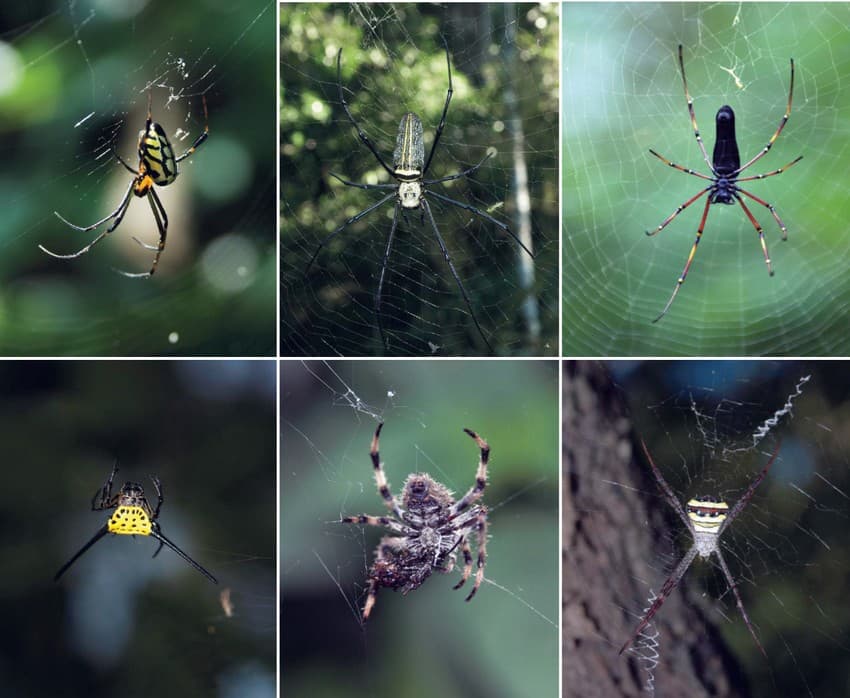
Spiders are arguably the most specialised insect predators. Most prominent among them are the orb weavers, a large group of over 2,800 species worldwide, belonging to the family Araneidae. The six species seen here clockwise (from top left): orchard spider Leucauge sp., giant wood spider Nephila pilipes, black wood spider Nephila kuhlii, banded fourleg or signature spider Argiope sp., garden orb weaver Neoscona sp., and long-horned orb Gasteracantha dalyi can be commonly seen in the Periyar Tiger Reserve. Wood spiders are the largest orb weavers of India with a web diameter ranging between three to four meters. Scorpions, which are also arachnids, are equally well adapted to hunt small arthropods. Periyar harbours many species of these nocturnal animals. Photos: Dr. Anish Andheria (top left, top centre, bottom left, bottom centre, bottom right). Photo: Ramnath Chandrasekhar (top right)
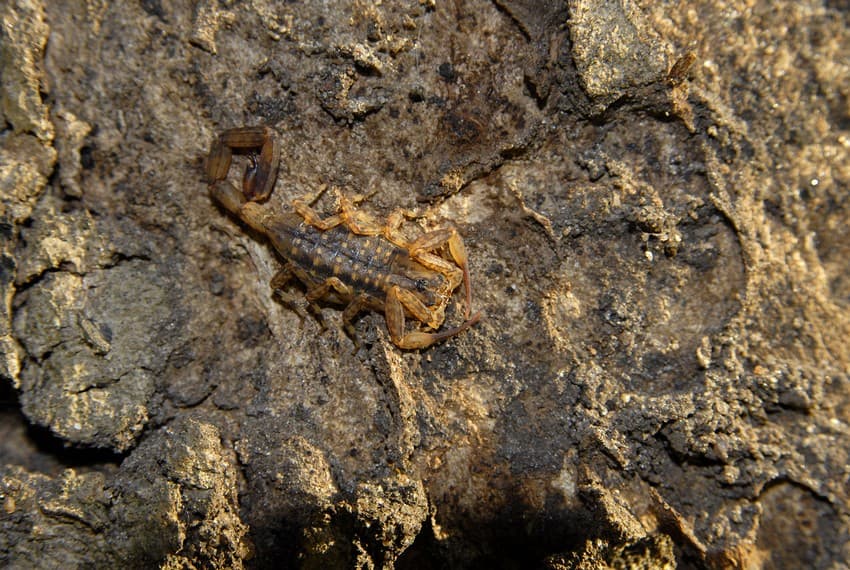
The bark scorpion Isometrus sp. has a flat and delicate body that allows it to squeeze into the narrow space between flakes of loose bark and the trunk of forest trees and stay hidden during the day. Photo: Dr. Anish Andheria
The Indian hump-nosed pit viper Hypnale hypnale camouflages itself extremely well against the dry leaf litter and is most often seen by unfortunate people, only after they step on one (another reason to ensure that an experienced guide is with you when out looking for reptiles). The arboreal large-scaled Trimeresurus macrolepis, the malabar T. malabaricus and the bamboo pit vipers T. gramineus, on the other hand, merge invisibly with the green vegetation on which they are found. All four species of pit vipers, though not uncommon in the evergreen and semi-evergreen areas of the park, cannot be on the list of most tourists because you need to enter the forest by night when the snakes are active. In Periyar, I recommend the Tiger Trail for this purpose, or the Jungle Patrol, which entails night patrolling in the fringes of the tiger reserve. Many of my snake sightings have been on such programmes that are well organised, but a relatively little utilised facility that Periyar offers.
Snakes such as the buff-striped keelback Amphiesma stolata, bronze-headed vine snake Ahaetulla perroteti, rat snake Ptyas mucosus and spectacled cobra Naja naja are diurnal and are more easily sighted. My only brief sighting of the elusive king cobra Ophiophagus hannah, the largest venomous snake of the world, was in the bamboo-dominated area of Chevaloda, just 20 minutes from the jetty.
I love reptiles. They are highly-evolved predators and they bring to my mind a world that pre-dates even the dinosaurs. Periyar’s forests are busy with my personal favourite, the Western Ghats flying lizard Draco dussumieri, an arboreal animal capable of gliding across the forest canopy, an exhilarating experience for those lucky enough to witness it. Males are often seen bobbing their heads and erecting their pale-coloured throat appendages to warn away rivals and to woo prospective mates. I have often spent hours watching these tiny reptilians as they position themselves along ant trails to feed at will on their favourite food. Once near the Mullayar watchtower, I painstakingly counted a female draco consume 73 weaver ants Oecophylla smaragdina within a span of 15 minutes.
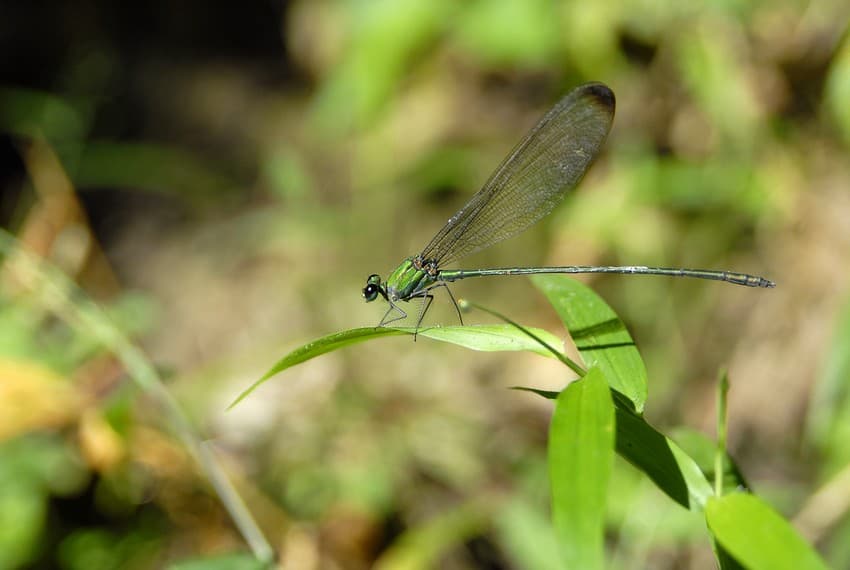
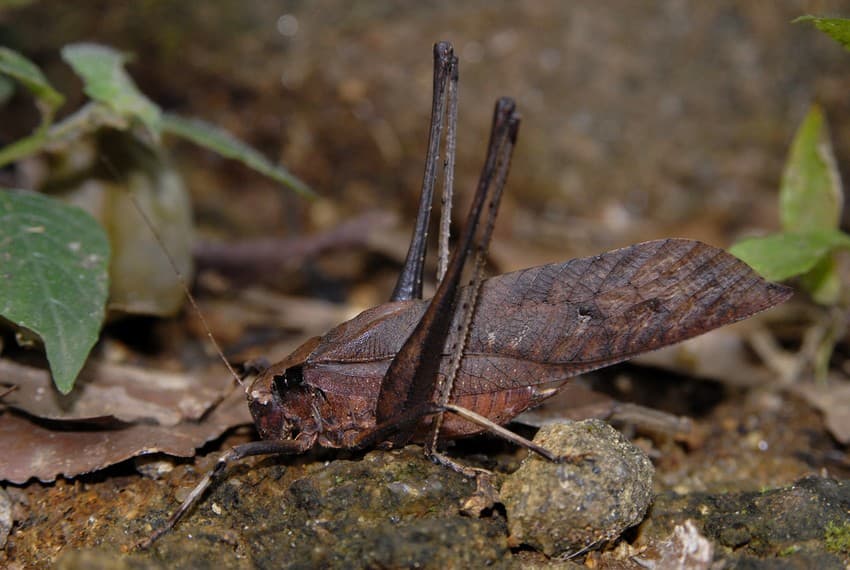
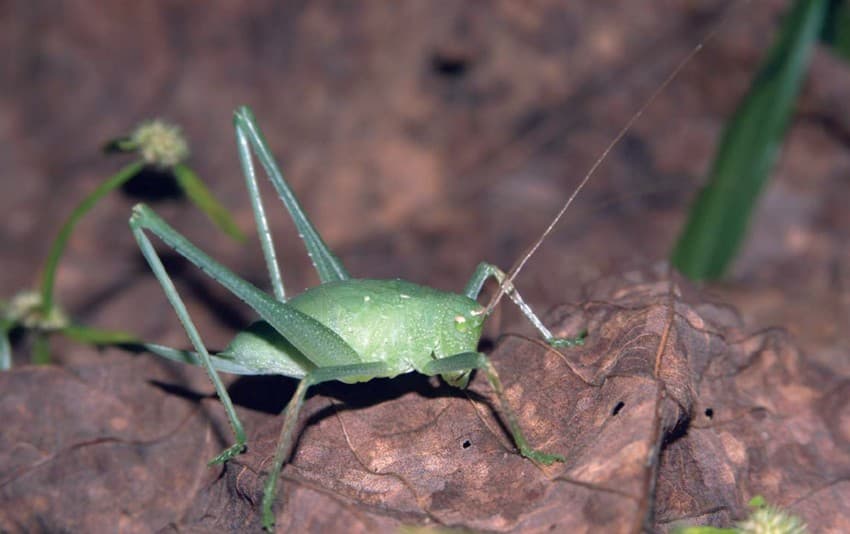
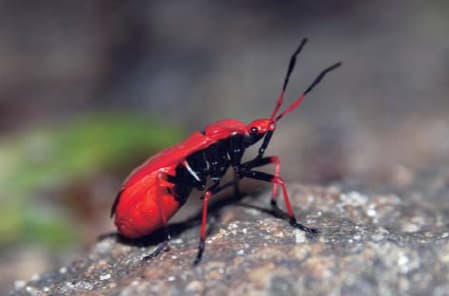
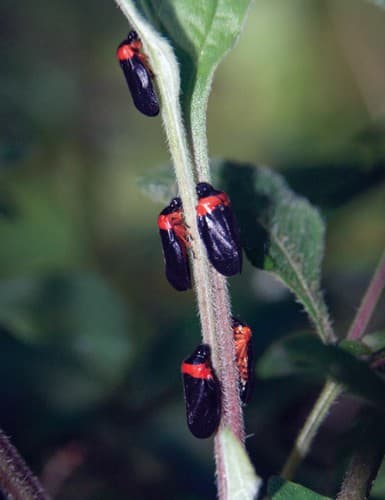
The multi-tier strata of Periyar teems with insects of every shape, size and colour. Some like the black-tipped forest glory Vestalis apicalis (first from top), a large species of damselfly, and the katydid nymph of the Family Tettigoniidae (second from top) use camouflage to avoid undue attention from predators, while others such as these leafhoppers belonging to the Family Cicadellidae (third from top) and the seed bug from the Family Lygaeidae (fourth and fifth from top) use bright colours to announce their distastefulness. The colour red is associated with danger and is effective against bird predators. Photos: Dr. Anish Andheria
Periyar draws me for so many reasons, including the urge to see species like the Nilgiri marten or the Indian star tortoise Geochelone elegans, or that special predator – the dhole. Often, I want to be there just to intercept a particular natural phenomenon such as the mass flowering of neelakurunji or Strobilanthes kunthiana, or the virtual eruption of frogs immediately after the first monsoon showers. But, invariably, when I reach Periyar I find it impossible to favour or isolate one species. The towering forests, the ethereal settings at the lake, the elephants and the gaur, the beetles and the bees take charge of my life and the distractions never stop. I begin admiring a train of ants walking across a forest path and end up imagining a sloth bear Melursus ursinus, probably attracted to the same ants I am watching. I know that Indian laburnum Cassia fistula seeds are scattered by the bear with its droppings and my thoughts drift from the animal to the forest it helps maintain. The realisation that everything around me is interrelated is both reassuring and worrying. Worrying, because humans too are an integral part of this complex fabric, and by virtue of their power, they could damage the foundation that binds these innumerable strands together. It is always a dilemma; whether to enjoy what one sees or worry about its future. But witnessing a moth emerge from its cocoon in broad daylight and then take to the air, after unfurling its wings to dry, reassures me that as long as places like Periyar exist, the creatures will exist. That is motive enough to last me the rest of my life, which I have dedicated to the protection of natural ecosystems.
————————————————————————————————————————————————————–
Periyar’s Top 10 Mammals
- Asian Elephant (Elephas maximus)
- Gaur (Bos gaurus)
- Tiger (Panthera tigris)
- Leopard (and black panther) (Panthera pardus)
- Dhole (Cuon alpinus)
- Indian giant squirrel (Ratufa indica)
- Lion-tailed macaque (Macaca silenus)
- Nilgiri langur (Trachypithecus johnii)
- Smooth-coated otter (Lutrogale perspicillata)
- Nilgiri tahr (Hemitragus hylocrius)
Birds
- Great Hornbill (Buceros bicornis)
- Malabar Grey Hornbill (Ocyceros griseus)
- White-bellied Treepie (Dendrocitta leucogastra)
- Malabar Trogon (Harpactes fasciatus)
- Great Cormorant (Phalacrocorax carbo)
- Hill Myna (Gracula religiosa)
- Malabar Parakeet (Psittacula columboides)
- Greater Racket-tailed Drongo (Dicrurus paradiseus)
- Mountain Hawk Eagle (Spizaetus nipalensis)
- Mountain Imperial Pigeon (Ducula badia)
Reptiles and Amphibians
- Golden frog (Rana aurantiaca)
- Bi-coloured frog (Clinotarsus curtipes)
- Large-scaled pit viper (Trimeresurus macrolepis)
- Indian hump-nosed pit viper (Hypnale hypnale)
- Malabar pit viper (Trimeresurus malabaricus)
- King cobra (Ophiophagus hannah)
- Indian rock python (Python molurus)
- Brook’s gecko (Hemidactylus brookii)
- Indian monitor (Varanus bengalensis)
- Common green forest lizard (Calotes calotes)
————————————————————————————————————————————————————–
Seed Dispersal
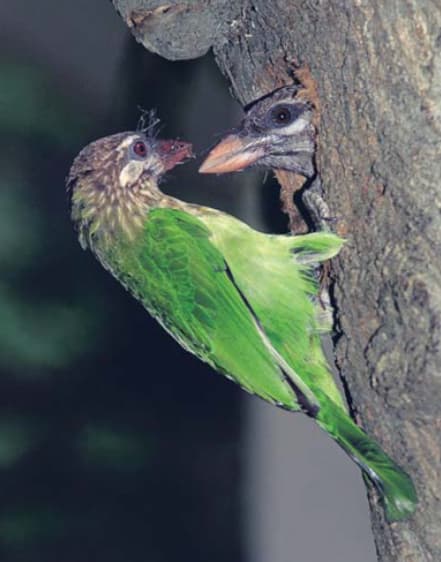
Photo: Vivek Sinha
All foragers expend time and energy seeking foods that will vary in digestibility, nutritional quality and accessibility. The extent to which an animal profits from eating a particular fruit depends on the size of the animal, the size of the fruit, and the nutritional quality of the pulp, minus the effort spent in acquiring it. Such factors determine the type of both dispersers and seeds. Research suggests that over 50 per cent of available fruit is removed by animals. The remaining fall directly below the parent tree from where wind and rain may transport them downstream. Nevertheless, the seed density beneath a parent tree is higher by orders of magnitude than in areas beyond 20 m. from it. The relatively little energy required to forage under trees that drop their fruit invites specialised ‘seed predators’ and this causes heavy depredation. To avoid this loss and to maximise reproductive success, plants have evolved strategies that control seed size and pulp quality, with the objective of encouraging dispersers to carry seeds as far from the trees as possible.
————————————————————————————————————————————————————–
Camouflage
The evolution of camouflage and the accompanying resting positions accentuating its effect enable various organisms to avoid detection by predators or prey. Camouflage does not conceal the animal. Rather, it makes it look like an inedible, uninteresting object, for instance, leaf-mimicking butterflies and leaf insects, stick-mimicking praying mantises and stick insects, dry grass-mimicking tigers and bark-mimicking geckos and bush crickets. If discovered, many cryptic organisms use a second line of defence primarily meant to startle their adversaries. The blue oakleaf butterfly, as the name suggests, resembles a dried lichen laden leaf. However, if discovered by a predator, it flashes the bright turquoise blue colour on the dorsal surface of its wings to surprise the predator, making it hesitate, while the butterfly makes good its escape. Whether an animal eats or is eaten depends on how deftly it utilises the attributes gifted by evolution. To have the necessary qualifications is all very well, but using them to one’s advantage is the key.
————————————————————————————————————————————————————–
Facts From Faeces
The health of a forest is generally estimated by measuring the population of large carnivores. Traditional census methods based on total counts have proved to be unreliable for carnivores and other elusive species. Radiotelemetry, while being useful for behavioural studies, is not very useful for population estimation because of logistical constraints. Photo-capture-recapture through camera traps is the most reliable technique so far for estimating large carnivore densities. But this technique also has limitations such as high cost of equipment, possibility of theft and vandalism and the need for highlytrained personnel. In difficult terrain, a low number of photographic captures is inevitable. Therefore, it is necessary to complement this method using other approaches. It is also important to develop simple pointers to determine population trends, as it would allow managers to base conservation on trends rather than exact numbers!
Recent advances in molecular biology have led to the extraction of DNA from very poor sources such as scats, and have allowed us to positively identify individual animals from such DNA. It is now known that a faecal bolus scrapes dead cells from the inner surface of the intestine each time an animal defecates. By extracting DNA from these cells, it is possible to identify the species and the individual responsible for producing that particular scat. Thus, if scats are systematically collected from an area, it is possible to identify individual animals even more effectively than is possible using photographs. Subsequently, by applying existing statistical analysis programmes, it will be possible to estimate the population of a particular species. With the current rate of biotechnological advancement, a nationwide tiger population survey based on scats is not distant.
Scats have also proved to be crucial in determining the prey profile of various carnivores. This is based on the fact that every mammal species can be identified from the macroscopic (texture, average length, colour and thickness) and microscopic (cortex colouration, medullary pattern, basal configuration and cuticular pattern) features of their hair. A widely-used field technique for understanding predator diets is identification of recognisable parts – generally hair, and to a lesser extent, hooves and bones – of prey that have passed through their digestive systems. Thus, scats can provide a snapshot of types of prey consumed. This has an advantage over other techniques because of the relative ease with which samples can be obtained and the non-destructive nature of the sampling procedure.
————————————————————————————————————————————————————–
Insect Decomposers
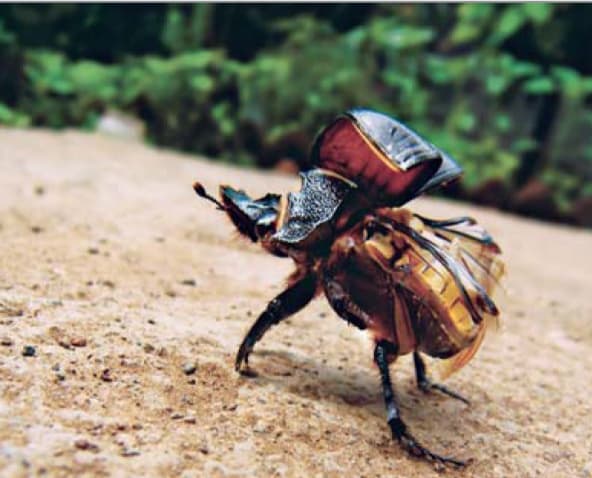
Dung beetle. Photo: C.R. Shelare
Dead plants and animals provide a rich source of food for countless organisms from microbial bacteria, fungi and nematodes, to relatively large earthworms and insects. These saprophagous organisms (eaters of rotten organic matter) are a vital link in a cyclic process that helps replenish soil nutrients. Among these, insects are most fascinating. Entomologists recognise several groups: those that feed on dead or dying plants, those that feed on dead animals, and those that feed on the excrements of other animals. The dead plant feeders include a range of soil and wooddwelling species such as wood lice, termites, springtails and beetles that shred leaves or tunnel into woody tissues. Such creatures accelerate the process of decay by increasing the surface area exposed to weathering and to the actions of other decomposers. They are largely responsible for creating a layer of humus, which acts as an incubator for bacteria, fungi and other microorganisms that make carbon, nitrogen, and other elements available for uptake by living plants. Carrion feeders include numerous beetles, larvae of flies (maggots), wasps, ants and mites. Each species colonises a dead animal for a limited period of time but, as a group, they rapidly consume decaying flesh. Blowflies, generally the first to arrive on a carcass, are also the first to complete development and depart. Other species follow over time in a relatively predictable sequence as the body decomposes. This can provide a reliable way to determine the time elapsed since death and has become a useful tool for forensic science! Many species of dung beetles and rove beetles are attracted to the odour of animal excrement. Adults lay their eggs on fresh faeces and their larvae feed on the undigested organic matter. Many dungfeeders exhibit distinct preferences for particular types of faeces – the species associated with deer pellets may be quite different to those found on carnivore scats.
This article was first published in the book ‘The Periyar Inheritance’, a Sanctuary publication.
——————————————————————————————————————————————————————
About the Author: President of the Wildlife Conservation Trust (WCT), which is involved in projects across central India, Dr. Anish Andheria’s focus research area has been predator-prey relationships. An accomplished naturalist and wildlife photographer, he has authored several scientific papers and books.
Disclaimer: The author is associated with Wildlife Conservation Trust. The views and opinions expressed in the article are his own and do not necessarily reflect the views and opinions of Wildlife Conservation Trust.
——————————————————————————————————————————————————————
Your donations support our on-ground operations, helping us meet our conservation goals.
——————————————————————————————————————————————————————
Related Links
- Quadripartite Association
- A Frog In A Bamboo Reed
- In Praise of the Ghost Tree
- Eurasian Otters – Lost and Found
- Careers
- Watch: Female leopard radio-collared at Sanjay Gandhi National Park

